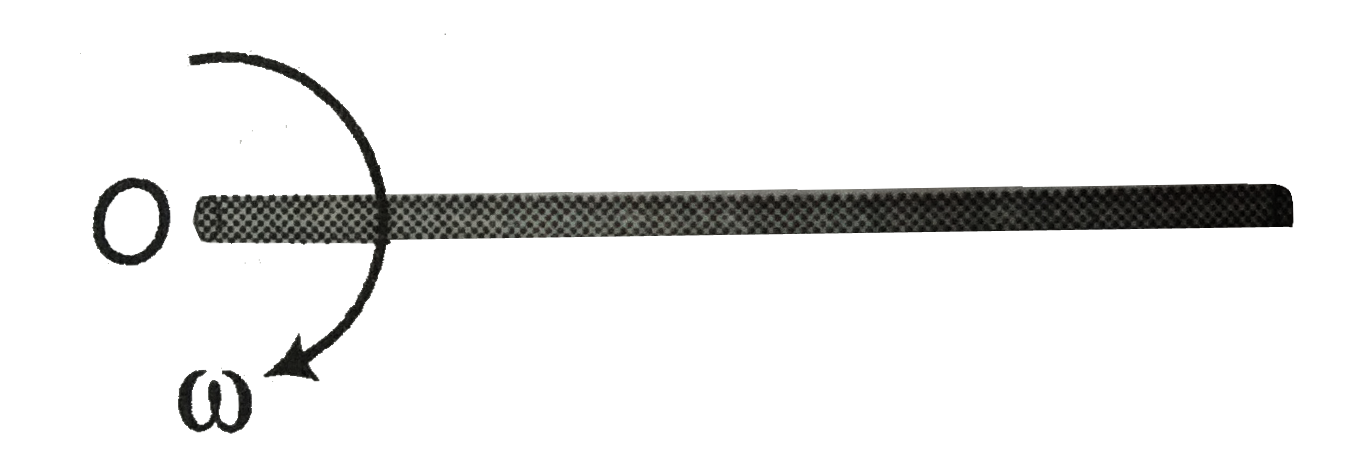A circular platform rotates around a vertical axis with angular velocity . On the platform is a' ball of mass , attached to the long axis of the platform by a thin rod of length . Find the normal force (in ). exerted by the ball on the platform. Assume friction is absent.
'(##CEN_KSR_PHY_JEE_C07_019_Q10##)'
The correct Answer is:4
Topper's Solved these Questions
Similar Questions
A circular platform rotates around a vertical axis with angular velocity ω=10rad/s. On the platform is a ball of mass 1kg, attached to the long axis of the platform by a thin of length of 10cm (α=30∘). Find normal force exerted by the ball on the platform (in newton). Friction is absent.

View SolutionA circular platform rotates around a vertical axis with angular velocity ω=10rad/s. On the platform is a ball of mass 1kg, attached to the long axis of the platform by a thin of length of 10cm (α=30∘). Find normal force exerted by the ball on the platform (in newton). Friction is absent.

View SolutionA small 100g sleeve B can slide on a smooth, circular and rigid wire frame A of radius 5m placéd in vertical plane. The wire frame is rotating about its vertical diameter at 2rads. When the sleeve is brought at a particular angular position other than the bottom and the top of the ring, the sleeve will not slide on the wire frame. What is force of interaction (in N) between the sleeve and the wire frame at this position?
'(##CEN_KSR_PHY_JEE_C07_020_Q11##)'
View Solution
A rod of mass 2 kg ad length 2 m is rotating about its one end O with an angular velocity ω=4rad/s. Find angular momentum of the rod about the axis rotation.
View Solution
A rod of mass 2 kg ad length 2 m is rotating about its one end O wth an angular velocity ω=4rad/s. Find angular momentum of the rod about the axis rotation.
View SolutionA rod of mass M and length l attached with a small bob of mass m at its end is freely rotating about a vertical axis passing through its other end with a constant angular speed ω. Find the force exerted by the system (rod and bob) on the pivot. Assume that gravity is absent.
View SolutionAs shown in the figure, a small ball is moving with speed 2v towards wall A and both the walls are moving with constant velocity v towards each other. Find the speed v( in m / s), if the time taken by the ball in first three collision is 5s. (Assume all collision are perfectly elastic and friction is absent)
'(##CEN_KSR_PHY_JEE_C08_E01_025_Q16##)'
View SolutionA concave mirror of focal length 20cm and a convex lens of focal length 10(~cm) are kept with their optic axis parallel but separated by 0.5mm as shown in the figure.The distance between the lens and the mirror is 10cm. An object of height 3min is placed on the optical axis of the lens at a distance of 15∘cm from the lens. Find the height of the image (in mm ) formed by the mirror after retion from the lens.
'(##CEN_KSR_PHY_JEE_C26_E01_037_Q18##)'
View SolutionIn the above figure, x is any instantaneous position. The mirror is rotating about z -axis with angular velocity ω 'in anticlockwise direction and the objećt is moving with velocity v along x -axis. If the magnitude of velocity of image is acms at the given instant, then find the value of 36a31, (Given: θ=30∘,ω=1rads,v=1cms,x=1m)
'(##CEN_KSR_PHY_JEE_C26_E01_022_Q08##)'
View SolutionA disc of mass 4kg and radius 6 metre is free to rotate in horizontal plane about a vertical fixed axis passing through its centre. There is a smooth groove along the diameter of the disc and two small balls of mass 2kgeachareplaced∈itoneithersofthecentreofthediscasshown∈figure.Thediscisgiven∈itialanga––rvelocityomega_(0)=12 (rad) / (s) released. Find the angular speed of disc (in radian/s) when the balls reach the ends to disc.
'(##CEN_KSR_PHY_JEE_C09_E01_016_Q06##)'
View Solution
